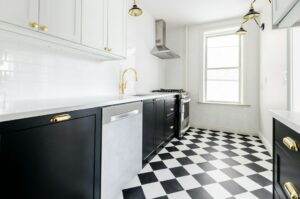Introduction
Whirlpool fridges are known for their reliability and quality, but like any appliance, they can experience issues over time. These issues can range from temperature problems to leaks, compressor issues, electrical problems, freezing and defrosting issues, and noise problems. Troubleshooting and repairing these issues is important to ensure that your Whirlpool fridge continues to perform at its best and to avoid costly repairs or replacements. In this article, we will explore the common issues with Whirlpool fridges, how to diagnose a faulty fridge, and provide tips for troubleshooting and fixing these issues.
Understanding Common Issues with Whirlpool Fridges
Whirlpool fridges can experience a variety of common issues that can affect their performance. One of the most common issues is temperature problems. This can include the fridge not cooling or freezing properly, which can lead to spoiled food or a buildup of ice. Leaks are another common issue with Whirlpool fridges, which can be caused by a faulty water dispenser or a clogged drain tube. Compressor issues can also occur, which can result in the fridge not cooling at all or not maintaining a consistent temperature. Electrical problems, such as a faulty thermostat or control board, can also affect the performance of the fridge. Freezing and defrosting issues can cause food to become frozen or thawed prematurely. Finally, noise problems can occur due to a faulty fan motor or condenser fan motor.
How to Diagnose a Faulty Whirlpool Fridge
Diagnosing a faulty Whirlpool fridge requires a step-by-step approach and the use of certain tools. The first step is to check the power supply and ensure that the fridge is properly plugged in. If the fridge is not turning on at all, it may be a power supply issue. Next, check the temperature settings on the fridge to ensure they are set correctly. If the fridge is not cooling or freezing properly, it may be a temperature problem. Use a thermometer to check the temperature inside the fridge and freezer compartments. If the temperature is not within the recommended range, there may be an issue with the thermostat or control board.
To diagnose leaks, inspect the water dispenser and check for any visible cracks or leaks. If there are no visible issues, check the drain tube for any clogs or blockages. Compressor issues can be diagnosed by listening for any unusual noises coming from the fridge or by checking if the compressor is running. Electrical problems can be diagnosed by checking the continuity of various components using a multimeter. Freezing and defrosting issues can be diagnosed by checking if the defrost heater is working properly. Finally, noise problems can be diagnosed by locating the source of the noise and inspecting the corresponding component.
Tips for Troubleshooting Whirlpool Fridge Temperature Issues
If you are experiencing temperature issues with your Whirlpool fridge, there are several troubleshooting steps you can take. First, check the temperature settings on the fridge and ensure they are set correctly. If the temperature is too high or too low, adjust the settings accordingly. Next, check for any obstructions in front of or inside the vents that may be blocking airflow. Clear any obstructions to allow for proper airflow. If the fridge is not cooling at all, check if the compressor is running. If it is not, there may be an issue with the compressor or its components.
If the fridge is not freezing properly, check if the freezer door is sealing properly. A faulty door seal can allow warm air to enter the freezer, preventing it from reaching the desired temperature. Replace any faulty door seals to ensure a proper seal. Additionally, check if there is a buildup of ice on the evaporator coils. If there is, it may indicate a problem with the defrost system. Clean the coils and check if the defrost heater is working properly. If not, it may need to be replaced.
How to Fix Whirlpool Fridge Leaks and Water Dispenser Problems
If you are experiencing leaks or water dispenser problems with your Whirlpool fridge, there are several troubleshooting steps you can take. First, check the water supply line for any leaks or kinks. If there are any issues with the water supply line, it may need to be replaced. Next, inspect the water dispenser and check for any visible cracks or leaks. If there are any issues with the water dispenser, it may need to be repaired or replaced.
If you are experiencing leaks inside the fridge, check the drain tube for any clogs or blockages. A clogged drain tube can cause water to back up and leak inside the fridge. Clear any clogs or blockages to allow for proper drainage. Additionally, check if the drain pan is cracked or damaged. If it is, it may need to be replaced. Finally, check if the ice maker is leaking. If it is, there may be an issue with the water inlet valve or the ice maker itself.
Troubleshooting Whirlpool Fridge Compressor Issues
If you are experiencing compressor issues with your Whirlpool fridge, there are several troubleshooting steps you can take. First, check if the compressor is running. If it is not running at all, there may be an issue with the power supply or the compressor itself. Check if the fridge is properly plugged in and if there are any issues with the power outlet. If everything checks out, it may indicate a problem with the compressor or its components.
If the compressor is running but the fridge is not cooling properly, check if there is a buildup of dust or debris on the condenser coils. A dirty condenser coil can prevent proper heat dissipation and cause the compressor to work harder than necessary. Clean the condenser coils to ensure optimal performance. Additionally, check if the condenser fan motor is running. If it is not, it may need to be replaced. Finally, check if there are any refrigerant leaks. If there are, it may indicate a problem with the compressor or the refrigerant system.
Dealing with Whirlpool Fridge Electrical Problems
If you are experiencing electrical problems with your Whirlpool fridge, there are several troubleshooting steps you can take. First, check if the fridge is properly plugged in and if there are any issues with the power outlet. If everything checks out, check if there is power going to the fridge by testing the power cord with a multimeter. If there is no power, it may indicate a problem with the power supply or the control board.
If there is power going to the fridge but it is not turning on or not functioning properly, check if there are any issues with the thermostat or control board. Test these components using a multimeter to check for continuity. If they are faulty, they may need to be replaced. Additionally, check if there are any loose or damaged wires inside the fridge. Tighten any loose connections and replace any damaged wires.
How to Address Whirlpool Fridge Freezing and Defrosting Issues
If you are experiencing freezing or defrosting issues with your Whirlpool fridge, there are several troubleshooting steps you can take. First, check if there is a buildup of ice on the evaporator coils. If there is, it may indicate a problem with the defrost system. Clean the coils and check if the defrost heater is working properly. If not, it may need to be replaced.
If the fridge is freezing food that should not be frozen, check if the temperature settings are set too low. Adjust the settings accordingly to prevent overcooling. Additionally, check if the door seal is sealing properly. A faulty door seal can allow warm air to enter the fridge, causing it to overcool. Replace any faulty door seals to ensure a proper seal.
Tips for Troubleshooting Whirlpool Fridge Noise Problems
If you are experiencing noise problems with your Whirlpool fridge, there are several troubleshooting steps you can take. First, locate the source of the noise. It may be coming from the fan motor, condenser fan motor, or compressor. Once you have located the source of the noise, inspect the corresponding component for any issues. If there are any issues, the component may need to be repaired or replaced.
If the noise is coming from the fan motor, check if there is a buildup of dust or debris on the blades. Clean the blades to ensure smooth operation. If the noise is coming from the condenser fan motor, check if it is running properly. If it is not, it may need to be replaced. Finally, if the noise is coming from the compressor, it may indicate a problem with the compressor itself. In this case, it may need to be repaired or replaced.
Preventative Maintenance Tips for Whirlpool Fridges
To prevent common issues from occurring with your Whirlpool fridge, there are several preventative maintenance tips you can follow. First, regularly clean the condenser coils to prevent a buildup of dust or debris. This will ensure optimal heat dissipation and prevent the compressor from working harder than necessary. Additionally, regularly check and replace the door seals if they are worn or damaged. This will ensure a proper seal and prevent warm air from entering the fridge.
Next, regularly defrost and clean the freezer compartment to prevent a buildup of ice or frost on the evaporator coils. This will ensure proper airflow and prevent freezing or defrosting issues. Additionally, regularly clean and inspect the water dispenser to prevent leaks or blockages. Finally, regularly check and tighten any loose connections or wires inside the fridge to prevent electrical problems.
Can the Troubleshooting Tips for Whirlpool Fridge Repair Also Apply to Other Brands of Refrigerators?
When dealing with troubleshooting common refrigerator issues, it’s important to understand that the tips for Whirlpool fridge repair can often be applied to other brands as well. Many common issues such as temperature fluctuations, strange noises, and leaks can have similar causes across different brands of refrigerators.
Table of Contents
- Introduction
- Understanding Common Issues with Whirlpool Fridges
- How to Diagnose a Faulty Whirlpool Fridge
- Tips for Troubleshooting Whirlpool Fridge Temperature Issues
- How to Fix Whirlpool Fridge Leaks and Water Dispenser Problems
- Troubleshooting Whirlpool Fridge Compressor Issues
- Dealing with Whirlpool Fridge Electrical Problems
- How to Address Whirlpool Fridge Freezing and Defrosting Issues
- Tips for Troubleshooting Whirlpool Fridge Noise Problems
- Preventative Maintenance Tips for Whirlpool Fridges
- Can the Troubleshooting Tips for Whirlpool Fridge Repair Also Apply to Other Brands of Refrigerators?
- Conclusion
Conclusion
Troubleshooting and repairing common issues with Whirlpool fridges is important to ensure optimal performance and to avoid costly repairs or replacements. By understanding the common issues, diagnosing faulty fridges, and following the troubleshooting tips provided in this article, you can effectively address temperature problems, leaks, compressor issues, electrical problems, freezing and defrosting issues, and noise problems. Additionally, by following the preventative maintenance tips, you can prevent these issues from occurring in the first place. Remember to always prioritize safety when troubleshooting or repairing your Whirlpool fridge and consult a professional if you are unsure or uncomfortable with any aspect of the process.
If you’re in need of whirlpool fridge repair, look no further than 911 Appliance. With their team of skilled technicians and years of experience, they can quickly diagnose and fix any issues you may be experiencing with your fridge. In fact, they even have a helpful article on their website that provides tips on how to troubleshoot common problems with whirlpool fridges. Check it out here for some valuable insights that may save you time and money.



